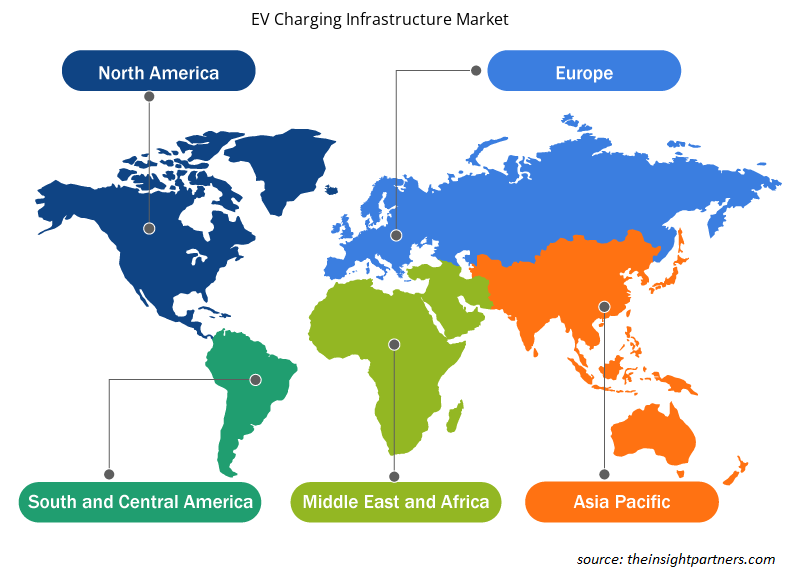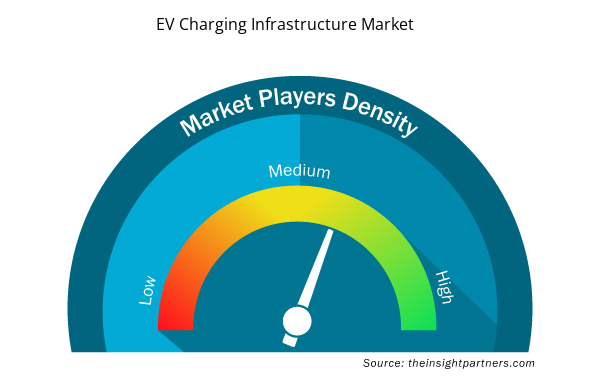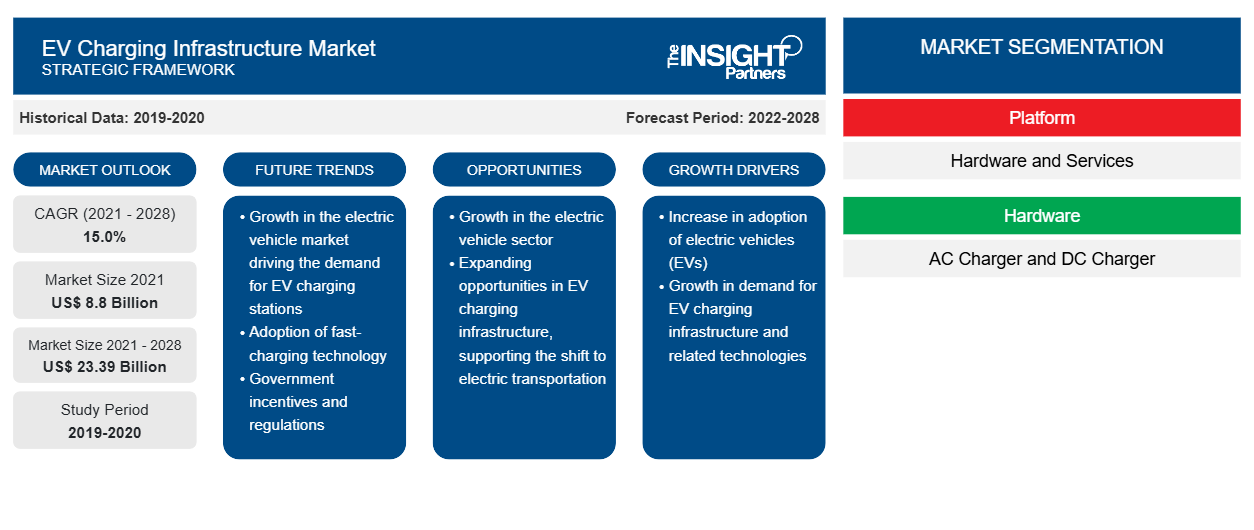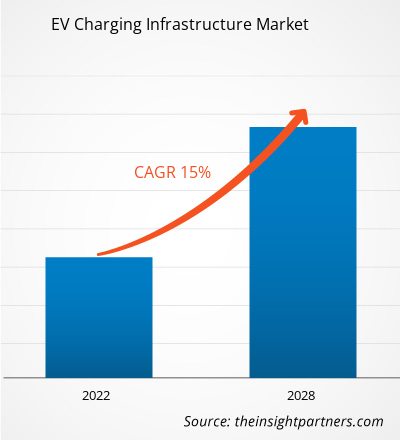[연구보고서] EV 충전 인프라 시장 규모는 2021년 88억 달러로 평가되었으며, 2028년에는 233억 9천만 달러에 이를 것으로 예상됩니다. 2021년부터 2028년까지 연평균 성장률 15.0%로 성장할 것으로 예상됩니다.
분석가 관점:
전기 자동차( EV ) 충전 인프라 시장은 지속 가능한 교통으로의 글로벌 전환에 힘입어 최근 몇 년 동안 상당한 성장과 발전을 이루었습니다. 더 많은 국가와 정부가 온실 가스 배출을 줄이고 기후 변화에 대처하기 위해 전기 자동차를 채택하는 것을 우선시함에 따라 안정적이고 효율적인 충전 인프라에 대한 수요가 급증했습니다. EV 충전 인프라는 전기 자동차 의 충전을 가능하게 하는 충전소 네트워크와 관련 기술을 말합니다 . 이러한 충전소는 가정, 직장, 공공 및 고속 충전소를 포함한 다양한 형태로 제공됩니다. 이들은 다양한 충전 요구 사항을 수용하고 EV 소유자에게 편의성을 제공하도록 설계되었습니다. EV 충전 인프라 시장 의 주요 원동력 중 하나는 확장되는 EV 시장 자체입니다. 전기 자동차 판매가 계속 증가함에 따라 증가하는 수의 EV를 지원하기 위해 견고한 충전 인프라에 대한 필요성이 중요해지고 있습니다. 시장 자체입니다. 전기 자동차 판매가 계속 증가함에 따라 도로에서
또한, 전기 자동차 도입을 촉진하는 정부 이니셔티브, 보조금 및 규정은 충전 인프라 개발을 촉진하는 데 중요한 역할을 했습니다. 여러 회사와 이해 관계자가 EV 충전 인프라 시장에 적극적으로 참여하고 있습니다. 여기에는 기존 자동차 제조업체, 에너지 회사, 충전 네트워크 운영자 및 기술 공급업체가 포함됩니다. 이들은 혁신적인 충전 솔루션을 개발하고, 충전 속도를 높이고, 사용자 경험을 개선하기 위해 협력합니다. 고속 충전 인프라는 장거리 여행과 범위 불안을 줄이는 데 필수적이며, EV 소유자가 장거리 여행 중에 차량을 빠르게 충전할 수 있도록 합니다. 게다가, 재생 에너지원을 충전 인프라에 통합하는 것이 인기를 얻고 있습니다. 재생 에너지로 구동되는 충전소는 충전과 관련된 탄소 배출을 줄이는 데 도움이 되어 전체 전기 이동성 생태계를 보다 지속 가능하고 환경 친화적으로 만듭니다.
시장 개요:
전기 자동차 충전소는 플러그인과 전기 자동차를 재충전할 전기 소스에 연결하는 데 사용되는 하드웨어입니다. 개인 사업체나 전기 공급 업체는 주차장, 쇼핑몰 및 기타 장소와 같은 공공 장소에 충전소를 설치합니다. 3핀 플러그, 공공 충전소 및 주거용 벽면 충전기는 모두 그리드에서 전기 자동차를 충전하는 간단한 방법입니다. 차량 대 그리드(V2G) 기술은 향후 몇 년 동안 차량 소유자가 피크 시간에 초과 전기를 그리드에 재판매할 수 있도록 할 것으로 예상됩니다.
귀하의 요구 사항에 맞게 이 보고서를 사용자 정의하세요
이 보고서의 일부 또는 국가 수준 분석, Excel 데이터 팩을 포함하여 모든 보고서에 대한 사용자 정의를 무료로 받을 수 있으며 신생 기업 및 대학을 위한 훌륭한 혜택과 할인 혜택을 이용할 수 있습니다.
- 이 보고서의 주요 시장 동향을 알아보세요.이 무료 샘플에는 시장 동향부터 추정 및 예측까지 다양한 데이터 분석이 포함됩니다.
시장 동인:
전기자동차 시장 확대로 EV 충전 인프라 시장 성장 견인
전기 자동차(EV) 시장의 발전은 EV 충전 인프라 시장 성장을 위한 중요한 원동력입니다. 전기 자동차에 대한 수요가 증가함에 따라 견고하고 광범위한 충전 인프라가 가장 중요해지고 있습니다. 여러 요인이 EV 시장 확대를 주도하고 있습니다. 기후 변화와 대기 오염을 포함한 환경 문제에 대한 인식과 우려가 커지고 있습니다. 향상된 배터리 용량과 더 긴 주행 거리를 포함한 EV 기술의 발전으로 전기 자동차의 매력과 실용성이 향상되었습니다. 배터리 기술이 계속 발전함에 따라 EV는 성능과 범위 측면에서 더욱 경쟁력을 갖추고 있으며, 제한된 주행 거리와 충전 가용성에 대한 잠재적 구매자의 우려를 해소하고 있습니다. 또한 자동차 제조업체는 전기 자동차 모델 개발에 많은 투자를 하고 있습니다. 자동차 산업의 주요 업체는 다양한 차량 세그먼트에 걸쳐 점점 더 많은 EV 옵션을 도입하여 다양한 소비자 선호도와 요구 사항을 충족하고 있습니다. EV 시장이 확대됨에 따라 포괄적인 충전 인프라에 대한 필요성이 중요해지고 있습니다. EV 소유자는 차량을 쉽고 효율적으로 충전할 수 있는 편리하고 안정적인 충전 솔루션이 필요합니다. 이러한 수요는 주거용 충전 옵션을 넘어 EV 소유자는 일상적인 출퇴근과 장거리 여행을 지원하기 위해 직장, 공공 장소 및 고속도로의 충전소에 접근할 수 있어야 합니다. 충전 인프라 제공업체, 에너지 회사 및 기타 이해 관계자는 더 큰 EV 차량의 요구를 충족하기 위해 충전 네트워크에 투자하고 확장하는 것이 중요하다는 것을 인식하고 있습니다. 그들은 정부, 자동차 제조업체 및 기타 산업 참여자와 협력하여 확장 가능하고 안정적이며 광범위하게 접근 가능한 충전 솔루션을 개발하고 있습니다.
세그먼트 분석:
EV 충전 인프라 시장은 플랫폼을 기준으로 하드웨어와 서비스로 구분됩니다. 하드웨어 부문은 2020년에 시장 점유율이 가장 높았습니다. 여러 요인으로 인해 하드웨어 부문이 EV 충전 인프라 시장에서 가장 큰 주주입니다. 다양한 위치에 충전소를 배치하는 것이 지배력에 기여합니다. 이 부문은 충전 인프라의 중추를 형성하는 충전소의 제조, 설치 및 유지 관리를 포함합니다. 레벨 1, 2 및 DC 고속 충전기를 포함한 다양한 충전 솔루션이 하드웨어 부문의 시장 점유율을 견인합니다. 충전 하드웨어의 기술적 발전과 물리적 인프라 투자의 수명이 길어지면서 그 입지가 더욱 공고해졌습니다. 하드웨어 부문의 더 큰 시장 점유율은 자본 집약적 특성과 안정적이고 효율적인 충전 네트워크를 구축하는 데 있어서 중요한 역할을 반영합니다.
지역 분석:
아시아 태평양 EV 충전 인프라 시장은 2021년에 39억 9,000만 달러 규모로 평가되었으며 2028년까지 1,077억 달러에 도달할 것으로 예상되며 예측 기간 동안 15.2%의 CAGR로 성장할 것으로 예상됩니다. 아시아 태평양 지역은 성장과 시장 점유율에 기여하는 몇 가지 주요 요인을 통해 EV 충전 인프라 시장에서 우위를 점했습니다. 이 지역은 전기 자동차 도입이 크게 급증하여 전 세계적으로 가장 크고 가장 빠르게 성장하는 전기 자동차 시장이 되었습니다. 중국, 일본, 한국과 같은 국가는 강력한 정부 지원, 인센티브 및 야심 찬 배출 감소 목표로 이러한 도입을 주도했습니다. 이러한 성장하는 전기 자동차 시장은 EV 충전 인프라에 대한 상당한 수요를 창출하여 이 지역의 지배적 위치로 이어졌습니다. 아시아 태평양 지역은 특히 중국과 한국과 같은 국가에서 잘 발달된 제조 생태계의 혜택을 받습니다. 이러한 국가는 충전소, 케이블 및 관련 구성 요소 제조에 상당한 투자를 하여 경쟁력 있는 가격으로 충전 인프라를 강력하게 공급했습니다. 이를 통해 충전 솔루션의 배포가 용이해지고 소비자의 접근성이 향상되었습니다. 또한 이 지역은 포괄적인 충전 네트워크를 구축하는 데 강력히 전념하고 있습니다. 정부와 산업 이해 관계자들은 주거 지역, 상업 단지, 공공 공간 및 주요 교통 회랑을 포함한 충전 인프라를 적극적으로 확장해 왔습니다. 이 광범위한 네트워크는 전기 자동차 소유자에게 편의성과 접근성을 보장하여 이 지역의 지배력을 더욱 공고히 합니다. 기술의 발전과 혁신도 아시아 태평양 지역의 시장 지배력에 기여했습니다. 고출력 충전소와 스마트 충전 솔루션을 채택하고 무선 충전과 같은 신기술을 탐색함으로써 EV 충전의 효율성과 사용자 경험이 개선되었습니다. 이러한 발전으로 인해 더 많은 소비자가 전기 자동차에 끌리고 충전 인프라에 대한 수요가 증가했습니다.
또한, 이 지역의 선도 기업과 시장 참여자들이 중요한 역할을 했습니다. BYD, NIO, 현대, LG전자를 포함한 아시아 제조업체는 충전 인프라에 상당한 투자를 하고 시장 도달 범위를 확대했습니다. 그들의 전문성, 기술 발전, 강력한 시장 입지는 아시아 태평양 지역의 EV 충전 인프라 시장 성장에 기여했습니다.
주요 플레이어 분석:
EV 충전 인프라 시장 분석은 Tritium, Blink Charging Co., ChargePoint, Inc., BP plc, EVBox, EVgo Inc., Tesla, Inc., Webasto Group, RWE AG, Delta Electronics, Inc.와 같은 업체로 구성되어 있습니다. EV 충전 인프라 업체 중에서 Tritium과 EVBox는 다양한 제품 포트폴리오로 인해 상위 2개 업체입니다.
EV 충전 인프라 시장 지역 통찰력
Insight Partners의 분석가들은 예측 기간 동안 EV 충전 인프라 시장에 영향을 미치는 지역적 추세와 요인을 철저히 설명했습니다. 이 섹션에서는 북미, 유럽, 아시아 태평양, 중동 및 아프리카, 남미 및 중미의 EV 충전 인프라 시장 세그먼트와 지리에 대해서도 설명합니다.

- EV 충전 인프라 시장에 대한 지역별 데이터 얻기
EV 충전 인프라 시장 보고서 범위
| 보고서 속성 | 세부 |
|---|---|
| 2021년 시장 규모 | 88억 달러 |
| 2028년까지 시장 규모 | 233억 9천만 달러 |
| 글로벌 CAGR (2021-2028) | 15.0% |
| 역사적 데이터 | 2019-2020 |
| 예측 기간 | 2022-2028 |
| 다루는 세그먼트 | 플랫폼별로
|
| 포함된 지역 및 국가 | 북아메리카
|
| 시장 선도 기업 및 주요 회사 프로필 |
|
EV 충전 인프라 시장 참여자 밀도: 비즈니스 역학에 미치는 영향 이해
EV 충전 인프라 시장 시장은 소비자 선호도의 변화, 기술 발전, 제품의 이점에 대한 인식 증가와 같은 요인으로 인해 최종 사용자 수요가 증가함에 따라 빠르게 성장하고 있습니다. 수요가 증가함에 따라 기업은 제품을 확장하고, 소비자의 요구를 충족하기 위해 혁신하고, 새로운 트렌드를 활용하여 시장 성장을 더욱 촉진하고 있습니다.
시장 참여자 밀도는 특정 시장이나 산업 내에서 운영되는 회사나 기업의 분포를 말합니다. 주어진 시장 공간에 얼마나 많은 경쟁자(시장 참여자)가 존재하는지 그 규모나 총 시장 가치에 비해 나타냅니다.
EV 충전 인프라 시장에서 운영되는 주요 회사는 다음과 같습니다.
- 드
면책 조항 : 위에 나열된 회사는 어떤 특별한 순서에 따라 순위가 매겨지지 않았습니다.

- EV 충전 인프라 시장 주요 주요 업체 개요 알아보기
최근 개발 사항:
합병 및 인수와 같은 무기적 및 유기적 전략은 EV 충전 인프라 시장에서 회사들이 많이 채택하고 있습니다. 최근 몇 가지 주요 시장 개발은 다음과 같습니다.
- 2022년 11월, 율루는 카르나타카 주 정부와 양해각서(MOU)에 서명하고 향후 5년 동안 10만 대의 전기 자동차(EV)를 배치하고 주에서 가장 큰 EV 배터리 충전 및 교환 인프라를 가동하는 데 120억 루피를 투자할 계획이라고 발표했습니다.
- 2022년 10월, 룩셈부르크 정부는 전기 자동차 충전 인프라 프로젝트에 투자하는 회사에 재정 지원을 제공하는 프로젝트에 대한 첫 번째 호출에 따라 29개 프로젝트가 선정되었다고 발표했습니다. 관련 회사는 최소 175킬로와트의 충전 용량을 갖춘 충전소 배치와 관련된 투자에 대해 최대 50%의 보조금을 받게 됩니다.
- 역사적 분석(2년), 기준 연도, CAGR을 포함한 예측(7년)
- PEST 및 SWOT 분석
- 시장 규모 가치/양 - 글로벌, 지역, 국가
- 산업 및 경쟁 환경
- Excel 데이터 세트


- Dry Eye Products Market
- Frozen Potato Market
- Saudi Arabia Drywall Panels Market
- Mobile Phone Insurance Market
- Drain Cleaning Equipment Market
- Health Economics and Outcome Research (HEOR) Services Market
- Virtual Event Software Market
- Nurse Call Systems Market
- Oxy-fuel Combustion Technology Market
- Underwater Connector Market

Report Coverage
Revenue forecast, Company Analysis, Industry landscape, Growth factors, and Trends

Segment Covered
This text is related
to segments covered.

Regional Scope
North America, Europe, Asia Pacific, Middle East & Africa, South & Central America

Country Scope
This text is related
to country scope.
자주 묻는 질문
Asia Pacific dominated the EV charging infrastructure market in 2020 with a share of 45.2% and is expected to continue its dominance by 2028. Europe is the second-largest contributor to the global EV charging infrastructure market in 2020, followed by North America.
The major companies in EV charging infrastructure market are Tritium; Blink Charging Co; ChargePoint, Inc.; BP p.l.c.; EVBox; EVgo Inc.; Tesla, Inc.; Webasto Group; RWE AG; and Delta Electronics, Inc.
The IEC Mode in EV charging infrastructure includes 2, 3, and 4. In terms of market share, the market was dominated by the 3 segment in 2020.
Based on platform, the global EV charging infrastructure market is segmented into hardware, and services. The EV charging infrastructure market was dominated by the hardware segment in 2020.
The rising concern of the transportation sector's impact on the environment has led to an unprecedented global requirement of decarbonizing transportation to meet climate goals and limit global warming, thereby increasing the adoption of low carbon technology in the transportation sector. The rising concerns for the adverse impact of transportation-related emissions and shift of consumer behavior toward zero-emission vehicles have resulted in a significant increase in the adoption of light-duty passenger vehicles across the globe, especially in strong economies, such as the US, China, and the European Union. The global share of new passenger EVs has risen at an average of nearly 50% per year since 2015. In 2021, the sales of electric vehicles surged by 160% in these top three markets. Notably, China has the largest fleet of electric vehicles globally, with 4.5 million electric cars, and Europe witnessed the largest annual increase to reach a total of 3.2 million electric passenger vehicles.
Presently, EV charging stations are more common in private residences. However, the rising consumer demand has led to an active adoption of on-site commercial charging as a standard building feature. China, the EU-27 plus the UK, and the US, are expected to implement charging in residential and commercial buildings to scale up the EV charging infrastructure in the near future, which requires upgrading buildings' electrical infrastructure to satisfy the rising demand for EV charging. Additionally, EV charging at scale is subject to the careful planning of a building's electrical distribution system, along with the local electric-grid infrastructure. To enhance the accessibility and affordability of electric chargers, a large number of building developers, urban planners, and electrical-equipment suppliers are actively integrating the EV charging infrastructure into standard building design plans.
Trends and growth analysis reports related to Automotive and Transportation : READ MORE..
The List of Companies - EV Charging Infrastructure Market
- De’Longhi Appliances S.r.l.
- The Whirlpool Corporation
- Koninklijke Philips N.V.
- Breville
- SMEG S.p.A.
- Hobart
- Ankarsrum Kitchen AB
- Wonderchef Home Appliances Pvt. Ltd.
- Kenwood Limited
- Hamilton Beach Brands, Inc.
The Insight Partners performs research in 4 major stages: Data Collection & Secondary Research, Primary Research, Data Analysis and Data Triangulation & Final Review.
- Data Collection and Secondary Research:
As a market research and consulting firm operating from a decade, we have published and advised several client across the globe. First step for any study will start with an assessment of currently available data and insights from existing reports. Further, historical and current market information is collected from Investor Presentations, Annual Reports, SEC Filings, etc., and other information related to company’s performance and market positioning are gathered from Paid Databases (Factiva, Hoovers, and Reuters) and various other publications available in public domain.
Several associations trade associates, technical forums, institutes, societies and organization are accessed to gain technical as well as market related insights through their publications such as research papers, blogs and press releases related to the studies are referred to get cues about the market. Further, white papers, journals, magazines, and other news articles published in last 3 years are scrutinized and analyzed to understand the current market trends.
- Primary Research:
The primarily interview analysis comprise of data obtained from industry participants interview and answers to survey questions gathered by in-house primary team.
For primary research, interviews are conducted with industry experts/CEOs/Marketing Managers/VPs/Subject Matter Experts from both demand and supply side to get a 360-degree view of the market. The primary team conducts several interviews based on the complexity of the markets to understand the various market trends and dynamics which makes research more credible and precise.
A typical research interview fulfils the following functions:
- Provides first-hand information on the market size, market trends, growth trends, competitive landscape, and outlook
- Validates and strengthens in-house secondary research findings
- Develops the analysis team’s expertise and market understanding
Primary research involves email interactions and telephone interviews for each market, category, segment, and sub-segment across geographies. The participants who typically take part in such a process include, but are not limited to:
- Industry participants: VPs, business development managers, market intelligence managers and national sales managers
- Outside experts: Valuation experts, research analysts and key opinion leaders specializing in the electronics and semiconductor industry.
Below is the breakup of our primary respondents by company, designation, and region:

Once we receive the confirmation from primary research sources or primary respondents, we finalize the base year market estimation and forecast the data as per the macroeconomic and microeconomic factors assessed during data collection.
- Data Analysis:
Once data is validated through both secondary as well as primary respondents, we finalize the market estimations by hypothesis formulation and factor analysis at regional and country level.
- Macro-Economic Factor Analysis:
We analyse macroeconomic indicators such the gross domestic product (GDP), increase in the demand for goods and services across industries, technological advancement, regional economic growth, governmental policies, the influence of COVID-19, PEST analysis, and other aspects. This analysis aids in setting benchmarks for various nations/regions and approximating market splits. Additionally, the general trend of the aforementioned components aid in determining the market's development possibilities.
- Country Level Data:
Various factors that are especially aligned to the country are taken into account to determine the market size for a certain area and country, including the presence of vendors, such as headquarters and offices, the country's GDP, demand patterns, and industry growth. To comprehend the market dynamics for the nation, a number of growth variables, inhibitors, application areas, and current market trends are researched. The aforementioned elements aid in determining the country's overall market's growth potential.
- Company Profile:
The “Table of Contents” is formulated by listing and analyzing more than 25 - 30 companies operating in the market ecosystem across geographies. However, we profile only 10 companies as a standard practice in our syndicate reports. These 10 companies comprise leading, emerging, and regional players. Nonetheless, our analysis is not restricted to the 10 listed companies, we also analyze other companies present in the market to develop a holistic view and understand the prevailing trends. The “Company Profiles” section in the report covers key facts, business description, products & services, financial information, SWOT analysis, and key developments. The financial information presented is extracted from the annual reports and official documents of the publicly listed companies. Upon collecting the information for the sections of respective companies, we verify them via various primary sources and then compile the data in respective company profiles. The company level information helps us in deriving the base number as well as in forecasting the market size.
- Developing Base Number:
Aggregation of sales statistics (2020-2022) and macro-economic factor, and other secondary and primary research insights are utilized to arrive at base number and related market shares for 2022. The data gaps are identified in this step and relevant market data is analyzed, collected from paid primary interviews or databases. On finalizing the base year market size, forecasts are developed on the basis of macro-economic, industry and market growth factors and company level analysis.
- Data Triangulation and Final Review:
The market findings and base year market size calculations are validated from supply as well as demand side. Demand side validations are based on macro-economic factor analysis and benchmarks for respective regions and countries. In case of supply side validations, revenues of major companies are estimated (in case not available) based on industry benchmark, approximate number of employees, product portfolio, and primary interviews revenues are gathered. Further revenue from target product/service segment is assessed to avoid overshooting of market statistics. In case of heavy deviations between supply and demand side values, all thes steps are repeated to achieve synchronization.
We follow an iterative model, wherein we share our research findings with Subject Matter Experts (SME’s) and Key Opinion Leaders (KOLs) until consensus view of the market is not formulated – this model negates any drastic deviation in the opinions of experts. Only validated and universally acceptable research findings are quoted in our reports.
We have important check points that we use to validate our research findings – which we call – data triangulation, where we validate the information, we generate from secondary sources with primary interviews and then we re-validate with our internal data bases and Subject matter experts. This comprehensive model enables us to deliver high quality, reliable data in shortest possible time.


 이 보고서에 대한 무료 샘플을 받으세요
이 보고서에 대한 무료 샘플을 받으세요